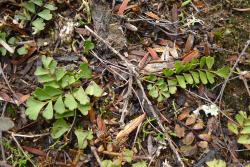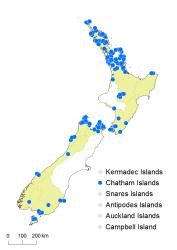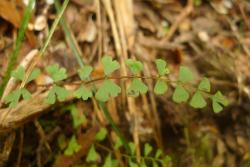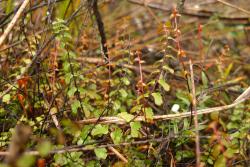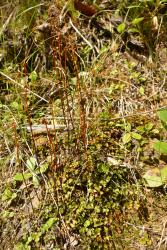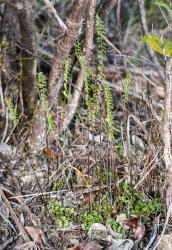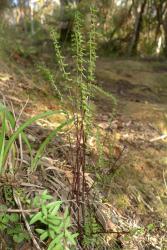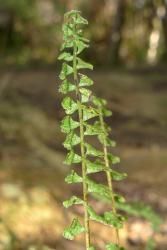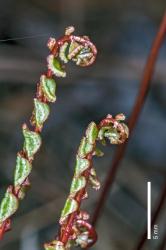- ≡ Adiantum lineare (Sw.) Poir., Encyc. Suppl. 1, 139 (1810)
- = Lindsaea lunata Willd., Sp. Pl. 5(1), 421 (1810) nom. illeg.
- = Lindsaea trilobata Colenso, Trans. & Proc. New Zealand Inst. 16: 345 (1884)
- ≡ Lindsaea linearis var. trilobata (Colenso) C.Chr., Mém. Acad. Roy. Sci. (Turin) 5: 398 (1906)
Rhizomes short- to long-creeping, up to 100 mm long (in herbarium specimens), 0.8–1.7 mm in diameter, with stipes arising 1–9 mm apart; bearing scales. Rhizome scales linear or narrowly ovate, 1–2 mm long, 0.1–0.2 mm wide, golden brown. Fronds dimorphic; fertile fronds 50–500 mm, rarely up to 700 mm long, held upright; sterile fronds 20–420 mm long, weakly ascending or prostrate. Stipes 50–390 mm long on fertile fronds, 10–150 mm long on sterile fronds, dark red-brown, glabrous or bearing scattered hairs up to 0.3 mm long. Rachises red-brown throughout, not winged, glabrous or bearing scattered hairs up to 0.4 mm long. Laminae 1-pinnate, linear, tapering to the apical pinna, 20–370 mm long in fertile fronds, 12–380 mm long in sterile fronds, 5–24 mm wide, light green on both surfaces, herbaceous, glabrous or bearing hairs up to 0.4 mm long near junction of pinnae with rachis. Primary pinnae in 8–44 pairs on fertile fronds, 3–27 pairs on sterile fronds, widely spaced especially proximally, flabellate; the longest at or below the middle, sessile or short-stalked, 3–13 mm long, 2–9 mm wide (the sterile slightly larger than the fertile); outer margin entire or shallowly lobed on fertile pinnae, crenate on sterile fronds. Sori extended along outer margins of pinnae; indusia extending laterally 3–12 mm, straight or slightly convex, free margin strongly toothed.
Lindsaea linearis is recognised by its dimorphic fronds (the sterile prostrate and the fertile erect), linear pinnate laminae, and flabellate primary pinnae. The indusia extend along the margins of the pinnae and are strongly toothed. The fertile pinnae often droop and shrivel in the poor, dry soils that the plant can tolerate.
North Island: Northland, Auckland, Volcanic Plateau, Gisborne, Southern North Island.
South Island: Western Nelson, Sounds-Nelson, Westland, Otago, Southland, Fiordland.
Chatham Islands, Stewart Island.
Altitudinal range: 15–1160 m.
Lindsaea linearis has a patchy distribution in New Zealand and is apparently largely absent from eastern parts of both main islands. In the North Island it occurs in coastal and lowland sites from Te Paki to Waikato and western Bay of Plenty, near East Cape, and around Wellington. It also occurs at higher elevations, from 750 to 1160 m, in the central North Island. In the South Island it occurs in coastal and lowland areas of north-west Nelson and the Marlborough Sounds, reaching 380 m on D’Urville Island. It is also known from scattered lowland sites in Westland, in the far south from Dunedin to Fiordland, and from Stewart Island and the Chatham Islands.
Also Australia (Western Australia, South Australia, Queensland, New South Wales, Victoria, Tasmania) and New Caledonia.
Lindsaea linearis is a terrestrial fern of poor soils, most frequently found growing under mānuka, kānuka, gorse or bracken, in grassland or sedgeland, but sometimes in kauri forest, or along tracks and on forest margins. It tolerates clay, peat, greywacke, gumland, pākihi, serpentine and ultramafic substrates, and is found on dry banks as well as in Sphagnum and peat bog.
n = 34 (Brownlie 1958). This number is unique in the genus and the lowest recorded for Lindsaea (Lehtonen et al. 2010).
The name Lindsaea lunata Willd. is a superfluous name, citing the earlier name, L. linearis Sw. in synonymy. The fact that L. linearis is not listed elsewhere by Willdenow (1810) indicates that he regarded it as a synonym, and that he was not simply comparing the two.



